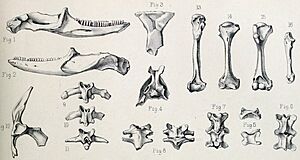Mauritian giant skink facts for kids
Quick facts for kids Leiolopisma mauritiana |
|
|---|---|
 |
|
| Fossils | |
| Conservation status | |
| Scientific classification | |
| Genus: |
Leiolopisma
|
| Species: |
mauritiana
|
| Synonyms | |
|
Didosaurus mauritianus |
|
The Mauritian giant skink (Leiolopisma mauritiana) was a very large type of skink, a kind of lizard. It lived only on the island of Mauritius. Sadly, this amazing creature became extinct in the 1600s. It likely disappeared because of new animals that humans brought to the island, which hunted the skinks.
Contents
Understanding the Mauritian Giant Skink
The Mauritian giant skink is related to other skinks from the area. For example, the Réunion giant skink (Leiolopisma ceciliae) was a close relative, but it is also extinct. A more distant relative that is still alive today is the Round Island ground skink (Leiolopisma telfairii), which also lives near Mauritius.
Fossils and Discoveries
Scientists don't have many complete remains of the Mauritian giant skink. They only have one partly complete skeleton and a few other bones. This makes it hard to learn everything about them. The skull of the known skeleton looks a bit like the skull of a blue-tongued skink (Tiliqua).
What Did the Mauritian Giant Skink Look Like?
Not much is known about what this species looked like or how it behaved. However, scientists believe it could grow to about 80 centimeters (31 inches) long. This size would make it one of the biggest skinks ever known.
Behavior and Diet of the Giant Skink
No one wrote down observations of the Mauritian giant skink's behavior when it was alive. But we can guess a lot about it by looking at skinks that are still around today.
Likely Habits and Food
It's very likely that the Mauritian giant skink acted much like other ground-dwelling skinks, such as the blue-tongued skink. This means it was probably an omnivore, eating a mix of things. Its diet might have included seeds, fruits, insects, and even small lizards. It was also probably good at digging burrows to hide or live in.
Temperament and Extinction
The Mauritian giant skink was probably a very calm animal, similar to modern ground skinks. It likely had little fear of humans. This lack of fear might have made it easier for new predators, brought by humans, to hunt them, which could have played a part in their extinction.
Movement and Habitat
Scientists think this skink might have lived in burrows or among rocks. This idea comes from studying its closest living relative, the Round Island ground skink. The Round Island skink often moves quickly through bushes or between rocks.


